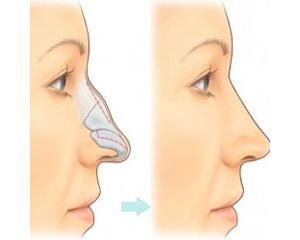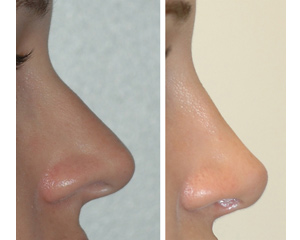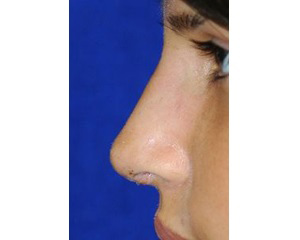rhinoplasty
Surgery Overview
Rhinoplasty is surgery to reshape the nose. It can make the nose larger or smaller; change the angle of the nose in relation to the upper lip; alter the tip of the nose; or correct bumps, indentations, or other defects in the nose.
During rhinoplasty, the surgeon makes incisions to access the bones and cartilage that support the nose. The incisions are usually made inside the nose so that they are invisible after the surgery. Depending on the desired result, some bone and cartilage may be removed, or tissue may be added (either from another part of the body or using a synthetic filler). After the surgeon has rearranged and reshaped the bone and cartilage, the skin and tissue is redraped over the structure of the nose. A splint is placed outside the nose to support the new shape of the nose as it heals.
What To Expect After Surgery
The splint and bandaging around your nose will be removed in about a week.
Your face will feel puffy and the area around your eyesand nose will be bruised and swollen for several days. Cold compresses can help minimize the swelling and reduce pain. Your doctor may also recommend pain medicine. It takes about 10 to 14 days before most of the swelling and bruising improves.
You may need to keep your head elevated and relatively still for the first few days after surgery. It may be several weeks before you can return to strenuous activities.
Why It Is Done
Rhinoplasty can change the size, shape, and angle of your nose and bring it into better proportion with the rest of your face.
Rhinoplasty may also correct structural problems with the nose that cause chronic congestion and breathing problems.



Nose Surgery (Rhinoplasty) Post-Operative Instructions
Instructions
- Have someone drive you home after surgery and help you at home for 1-2 days.
- Get plenty of rest.
- Follow balanced diet.
- Decreased activity may promote constipation, so you may want to add more raw fruit to your diet, and be sure to increase fluid intake.
- Take pain medication as prescribed. Do not take aspirin or any products containing aspirin unless approved by your surgeon.
- Do not drink alcohol when taking pain medications.
- Even when not taking pain medications, no alcohol for 3 weeks as it causes fluid retention.
- If you are taking vitamins with iron, resume these as tolerated.
- Do not smoke, as smoking delays healing and increases the risk of complications.
Activities
- Start walking as soon as possible, this helps to reduce swelling and lowers the chance of blood clots.
- Do not drive until you are no longer taking any pain medications (narcotics).
- Return to work in 1-2 weeks.
- Avoid strenuous activities or any activity that increases your blood pressure for 2-3 weeks.
- Avoid body contact sports, hitting or rubbing your nose, and sunburn for 2 months.
Incision Care
- Avoid exposing scars to sun for at least 12 months.
- Always use a strong sunblock, if sun exposure is unavoidable (SPF 30 or greater).
- Keep steri-strips on.
- Keep incisions clean and inspect daily for signs of infection.
- Stay in bed with your head elevated (except for going to the bathroom) for the first day.
- Cold compresses will reduce swelling.
- Do not shampoo your hair until nose splint is removed, or ask for special instructions.
- Avoid blowing your nose for 1 week.
- Be gentle when washing your face and hair or using cosmetics.
- Do not use facial makeup on external incisions until advised by surgeon.
- Contact lenses can be worn as soon as you feel like it, but glasses cannot be worn until your nose is completely healed (approximately 2 months). After your nose splint is removed, tape your glasses to your forehead or prop them on your cheeks until completely healed.
What To Expect
- You may be up and about in 2 days, but it will be several weeks before you are entirely up to speed.
- Feeling depressed is normal.
- After surgery, particularly during the first 24 hours, your face will feel puffy.
- A small amount of bleeding is common during the first few days.
- A splint is applied immediately after surgery for 7 days. Nasal packs may also be used.
- Minimal postoperative pain.
- Your nose may ache and you may have a dull headache.
- Temporary swelling and bruising around eyes and nose will increase at first and peak after 2 or 3 days. Most swelling and bruising should disappear within 2 weeks. Some subtle swelling (noticeable only to you) will remain for several months.
- Healing is a slow and gradual process.
- Some numbness may be present around the operative areas.
- Black eyes and swollen nose and eyelids for 7-14 days.
- You may experience some discomfort with breathing.
- Swollen nasal tissues may cause nose to seem "stuffed up" for several weeks.
Appearance
- New nose looks better in 2-3 weeks and usually continues to improve for many months.
- Nasal tip drops to its permanent position in 3-6 months.
- Final results may not be apparent for a year or more.
Follow-Up Care
- If you have nasal packing, it will be removed after a few days.
- If nostrils are narrowed, sutures are removed in 3 days. All other sutures either dissolve or are removed within 14 days.
- Frequent follow-up visits should be scheduled.
